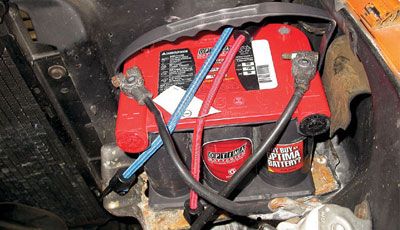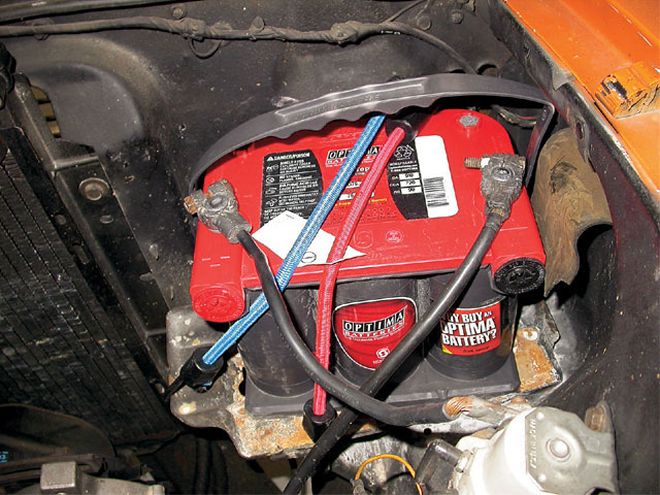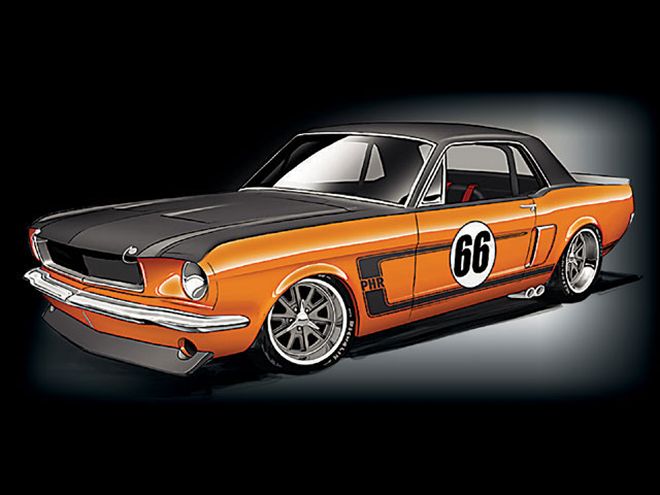
 This is actually better than what we started with. A generic, oversized battery was placed on the battery tray with nothing to hold it in place. To get it to its place of surgery, we replaced it with an Optima red-top battery and strapped it down the best we could. This is not recommended for long-term!
This is actually better than what we started with. A generic, oversized battery was placed on the battery tray with nothing to hold it in place. To get it to its place of surgery, we replaced it with an Optima red-top battery and strapped it down the best we could. This is not recommended for long-term!
I've had lots of experience with early Chevys, but it's about time I expand my horizons. I'm a fan of the SCCA Trans-Am series of the late 1960s and early '70s, and visualized my Camaro to follow that theme. Over the past seven years, my '68 Camaro took a path more on the tame side. This Mustang is my opportunity to build up a brutal, no-nonsense street-legal race car with a license plate and functioning headlights.
We bought this 1966 Mustang as a barely running straight-six automatic. Knowing in advance that most of the drivetrain and suspension components would be replaced, it didn't matter much what the car started life as. Of course, the first day we went to drive it after the sale, it didn't start. The battery was dead, and once we put the new one in, it cranked forever without even a backfire to assure that there was fuel or spark. I believe it's the car's way of telling us it's ready for an upgrade.
There will be no stereo, no A/C, no carpet, no over-the-top fancy polished pieces to distract you from its pavement-pounding roots. The objective is to build a lightweight, all-business street car with style. The playbook contains a full coilover suspension, rollcage, big disc brakes, a pump-gas high-rpm small-block, and two race seats.
The last 35 years of technology will have its place in the car; modernized instrumentation and suspension will fill the voids that parts from the 1960s couldn't. We'll be borrowing tricks picked up over the years to make this car perform effortlessly. My own touches will be evident as well: orange paint, satin finishes, and a downplayed look on performance parts.

The first order of business-lightening things up-was inspired by our October 2008 story called "Lighten Your Load." In a nutshell, I decided to take my own advice. Weight in the front of the vehicle is detrimental to the car's handling at the road course and the dragstrip. Around the corners, weight on the nose makes the car more prone to understeer, a less-than-favorable way to get around the track. At the dragstrip, for optimal rear-wheel traction, the weight needs to transfer rearward, where every pound helps.
An easy, cost-effective way to help move the weight to the rear is to relocate the battery to the trunk. Moving a 40-pound weight from the most forward location possible to the most rearward seems like a no-brainer. There are other advantages that come along with the newfound space up front. The overall cleaner look of the engine bay and the race-car look of the battery box can be incentives. For my situation, it was a mandatory move. Early Mustangs suffer from an overcompact engine bay that limits the radiator size you can use. The factory unit looks like it would be more at home in front of an import than a fire-breathing V-8. In Southern California, the cooling system is very important, and to make room in an early Mustang, the battery needs a new home.
We picked up a battery relocation kit from Taylor Cable, put together specifically for our Optima battery of choice. We like to use the Optimas because they won't leak, and can be mounted in any orientation. The battery relocation kit comes with the box in three pieces (bottom, body, and lid), positive battery cable and terminals, ground cable, cable retainers, vent tube, hold-down assembly, and all the hardware to make it work. We only needed to make one trip to the parts store for a longer ground cable to fit our specific routing plan.